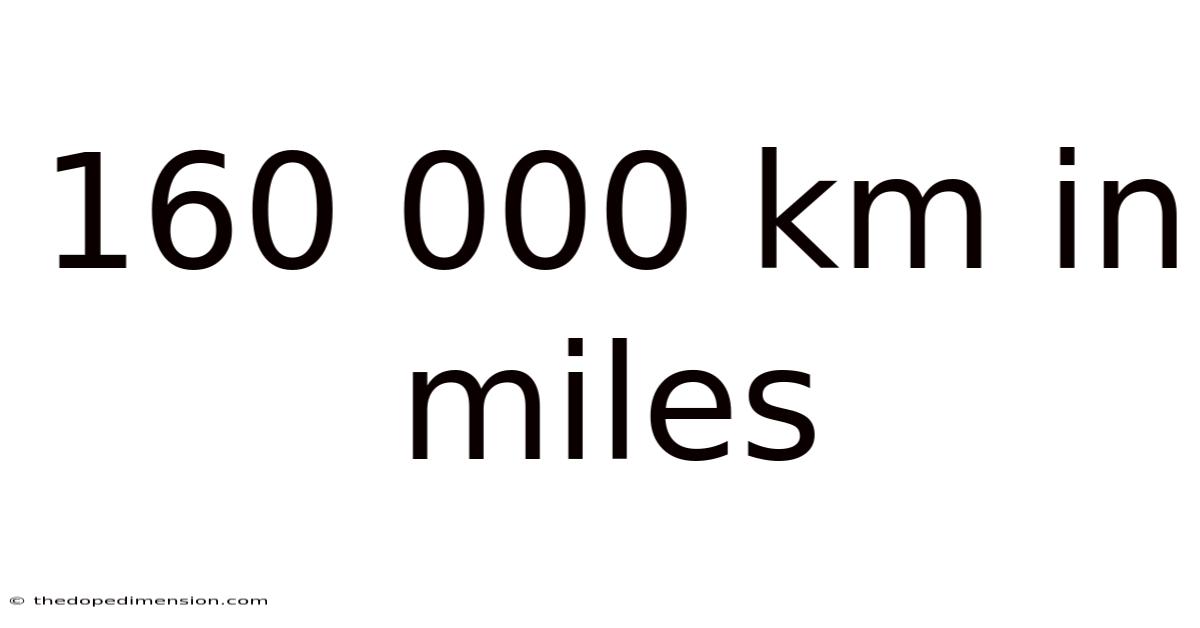160 000 Km In Miles
thedopedimension
Aug 27, 2025 · 4 min read

Table of Contents
160,000 km in Miles: A Comprehensive Guide to Metric-Imperial Conversion and Long-Distance Travel
Converting kilometers to miles is a common task, especially for those who travel internationally or work with vehicles that use different unit systems. This comprehensive guide will explore the conversion of 160,000 kilometers to miles, offering not only the simple answer but also delving into the intricacies of the conversion process, its applications, and some fascinating facts about long-distance travel. We will also address frequently asked questions and provide context for understanding this significant distance.
Understanding the Kilometer-Mile Conversion
The fundamental difference between kilometers and miles lies in their definition. A kilometer (km) is a unit of length in the metric system, equal to 1,000 meters. A mile (mi) is a unit of length in the imperial system, and its length varies slightly depending on the specific definition used (statute mile, nautical mile, etc.). The most commonly used mile is the statute mile, which is approximately 1.609 kilometers.
Therefore, to convert kilometers to miles, we use the conversion factor: 1 km ≈ 0.621371 miles. This means that one kilometer is roughly equal to 0.621371 miles.
Calculating 160,000 km in Miles
To find the equivalent of 160,000 kilometers in miles, we simply multiply the number of kilometers by the conversion factor:
160,000 km * 0.621371 mi/km ≈ 99419.36 miles
Therefore, 160,000 kilometers is approximately equal to 99,419.36 miles.
This is a considerable distance, roughly equivalent to circumnavigating the Earth approximately 2.5 times at the equator. Let's explore what this distance represents in different contexts.
Contextualizing 160,000 km (99,419.36 miles):
-
Driving: Driving 160,000 kilometers would involve significant time on the road. Assuming an average speed of 60 mph (approximately 96 km/h), it would take approximately 1,667 hours of continuous driving, or around 70 days without factoring in stops, rest, or sleep.
-
Flying: In air travel, 160,000 km is a substantial distance, representing multiple long-haul flights. This distance could easily cover multiple transcontinental journeys, such as several round trips between New York and London, or even multiple trips around the globe.
-
Vehicle Mileage: For car owners, reaching 160,000 kilometers on a vehicle signifies a significant milestone, suggesting substantial usage and potentially the need for major maintenance.
-
Global Perspective: The distance of 160,000 kilometers is nearly the equivalent of driving across the United States multiple times, or traversing significant portions of the world's landmasses.
The Significance of Accurate Conversion
Accurate conversion between metric and imperial units is crucial in various fields:
-
International Trade: Global commerce often involves units from different systems, requiring precise conversions to avoid errors and misunderstandings.
-
Engineering and Manufacturing: Manufacturing processes, especially those involving international collaborations, rely on precise measurements, and incorrect conversions can lead to significant problems.
-
Navigation and Mapping: Global Positioning Systems (GPS) and mapping software seamlessly handle conversions, allowing users to work with either system comfortably.
-
Scientific Research: Scientific research often involves data collected using different units, necessitating accurate conversion for data analysis and comparison.
Frequently Asked Questions (FAQ)
-
Q: How do I convert miles back to kilometers?
- A: To convert miles to kilometers, simply use the inverse of the conversion factor: 1 mile ≈ 1.60934 kilometers. Multiply the number of miles by this factor.
-
Q: Are there any online converters available?
- A: Yes, numerous websites and apps offer quick and easy kilometer-to-mile conversions. These tools are invaluable for quick calculations.
-
Q: What is the difference between a statute mile and a nautical mile?
- A: A statute mile is the standard land mile, while a nautical mile is based on the Earth's circumference and is used in navigation. A nautical mile is approximately 1.15 statute miles (1.852 km).
-
Q: Why are two different unit systems still used?
- A: The continued use of both systems is a result of historical factors and inertia. While the metric system is widely adopted internationally, the imperial system persists in some countries, primarily the United States. Transitioning entirely to one system would be a monumental task.
Conclusion: 160,000 km – A Journey of Significant Distance
160,000 kilometers (approximately 99,419.36 miles) represents a truly considerable distance. Whether you're planning a long road trip, analyzing vehicle mileage, or working with international data, understanding this conversion is crucial. This guide provided not only the simple calculation but also contextualized the significance of this distance, highlighted the importance of accurate conversion, and addressed frequently asked questions. The conversion from kilometers to miles, while seemingly straightforward, underlines the importance of understanding unit systems and the practical implications of their differences in various aspects of our lives. Hopefully, this guide provides you with a clearer understanding and appreciation of this substantial distance.
Latest Posts
Latest Posts
-
Quarts To Cubic Feet Conversion
Aug 27, 2025
-
45 Inches How Many Feet
Aug 27, 2025
-
30 000 Minutes To Days
Aug 27, 2025
-
How Many Inches Is 98cm
Aug 27, 2025
-
How Many Mm 1 Meter
Aug 27, 2025
Related Post
Thank you for visiting our website which covers about 160 000 Km In Miles . We hope the information provided has been useful to you. Feel free to contact us if you have any questions or need further assistance. See you next time and don't miss to bookmark.